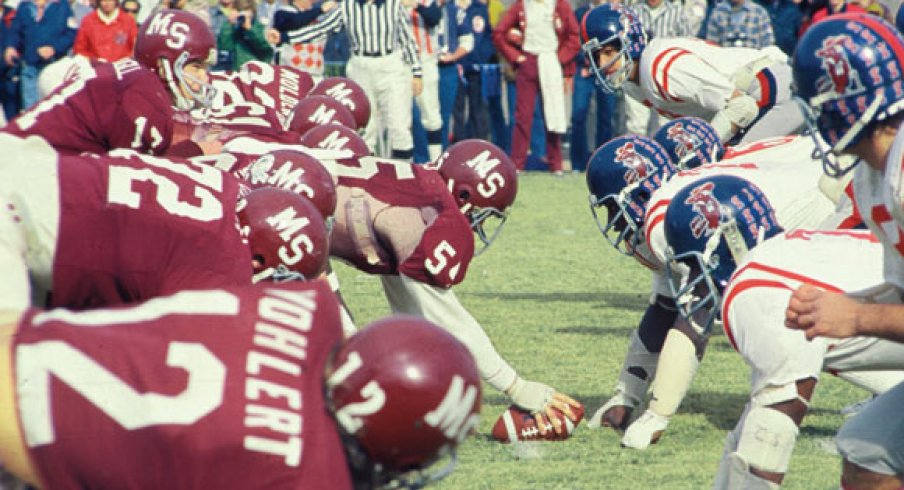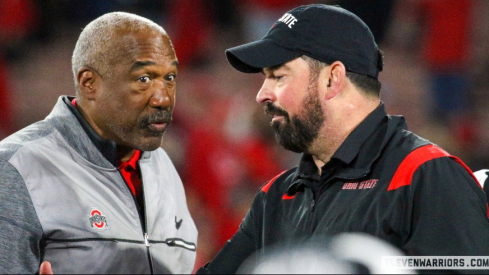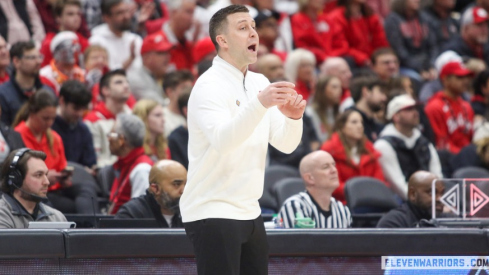Imagine that you're an Ole Miss football player in 1921. You just came back from the big pole sitting, exhausted after dancing the Charleston and swallowing goldfish inside a phonebooth with 20 of your closest friends. Breathless, your coach runs up to you and shakes your shoulders violently.
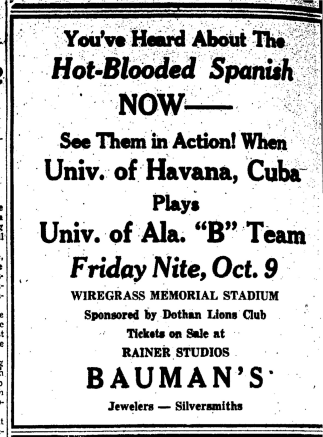
"Listen here, fish! You can stand around here getting ossified while you and your dumb Doras trip for biscuits all night long, or you can get ready because we are on our way to hotsy-totsy Havana for a real whoopee of a game!"
Wow! Really coach? You mean it?
"I'm always on the level, son. Now get out of that snuggle buggy before I upchuck all over that jitney."
And then you go ahead and protest against allowing dames to vote and then decide buy a lot of high risk stock on margin or something.
Anyway, that really happened! Well, obviously the whole women's suffrage movement and the stock market crash, but the Havana thing too. It was called the Bacardi Bowl (no joke), and it was played 10 times between 1907 and 1946. Ole Miss would actually somehow manage to lose that game in 1921, to the Cuban Athletic club, in part due to the residual effects of sea sickness and not taking the game particularly seriously. Havana was seen as the perfect get away for nouveau riche southern football teams looking to beat up on a venerable institution founded in the early 1700s. Which they did, a lot, although sometimes they picked on Villanova or Tulane.
In fact, there are a lot of really strange-but-true bowl games in the history of college football. The Bacardi Bowl stopped being played after, well, the whole Batista dictatorship business, but that didn't stop college football teams and conferences from risking life and limb to put on essentially meaningless exhibitions in the name of entertaining a few thousand bored locals with nothing better to do on a lazy Saturday in December.
I'm also especially fond of the College All-Star Game, which was played from 1934 to 1976, in an effort to prove once and for all who was better at football: an assortment of college students who had just met each other a few weeks prior, or a squad of paid adult professionals who had just proven themselves the best team in their league after months and months of hard fought victories.
Yes, it was an exhibition game for charity, but that didn't mean that the pros were going to give the college all-stars any sort of hope for victory. And the didn't, winning 31 of the 42 games overall and 16 of the last 17 that they played. Turns out that professionals are called professionals for a reason. Still, the College All-Star Game isn't really notable for how it was played, it's notable for how it ultimately ended.
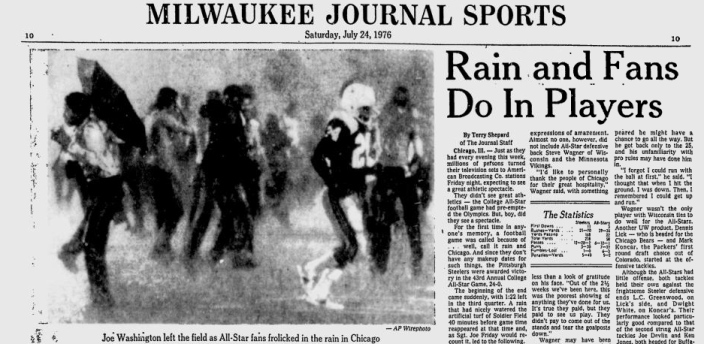
The "and fans" part of that headline is the operative part, because around 2,000 people correctly came to the conclusion that torrential rain and mud made for better partying than a three hour exhibition of humiliation, stormed Soldier Field, and ended the game sometime in the 3rd quarter.
Event organizers gave up pretending that the event wasn't a gigantic waste of time for everybody involved (except, I guess, Chicago charities), and stopped playing the game after that. It was a dumb idea with a noble goal, and hell, it lasted for decades until the NFL figured out amphetamines.
Still, it isn't as great an achievement as one plucky Italian-American boxer, fighting for his country and the memory of his dead friend, defeating a seemingly invincible Soviet machine made from steroids and body oil.
That's Rocky IV. Rocky V was him fighting some palooka in an alley, but what it should've been was the almost Glasnost Bowl, a hypothetical game to open the 1989 football season between USC and Illinois that was to take place in the very beating heart of the Soviet Union, Moscow. Gorbachev had instituted this policy of cultural and economic openness, and while most people hadn't yet realized that it signaled the death knell of the USSR, there were definitely no shortage of people looking to cash in.
The whole thing was sponsored by Raycom Sports. Though the game initially seemed like a good idea in the minds of sports advertising executives, actually breaking through decades of pent up animosity and mistrust in two different countries proved way too difficult and the whole thing blew up in their faces.
The Soviet Union of course broke up soon afterwards, and now Raycom Sports is the distributor of ACC football games, so that's pretty unfortunate all around. Illinois ended up upsetting USC in LA that year, which is probably for the best because who knows how long the Soviet Union would've held out after being inspired by the Fighting Illini's collectivist determination versus USC's flash and dash individualist pragmatism.
Ultimately, yes, it risked nuclear war and global annihilation. But you can't tell me that a Glasnost Bowl wouldn't have kicked some ass.
Here's The Point. We have had college bowl games in Cuba, Ireland, and Japan. We've pitted teacher's colleges against half-drunken rednecks. We once tried to end a multi-generational political conflict between world superpowers that were itching to kill each other with nuclear weapons with iso plays off left tackles. We even played a bowl game in Cleveland, IN DECEMBER.
Why then, are the location of modern college football bowl games largely restricted to the landed gentry of the south? Isn't it a slap in the face of to the absolutely insane history of the game to settle on Memphis as a safer (and therefore more profitable) location, rather than risk a freak snowstorm in an outdoor stadium in, I don't know, rural South Dakota or something?
Look, it isn't just about the competitive advantage that southern football teams enjoy year after year come bowl season. It's that the spirit of college football has always been a desire to pick the opposite of the safe bet and try something ludicrous. More bowl games above the Mason-Dixon line would be a good start.
More bowl games played on a giant platform in the Yellow Sea next to a video screen large enough to watch the game from mainland North Korea would be even better.
